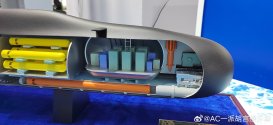I was doing some thought experiments today with
@BoraTas
Big question in my mind, how good and how much range and capabilities can we expect out of a XLUUV?
things to consider that since you don't have humans in the submersible, you can devote greater % of space to batteries. You don't have to ever ventilate since there is nobody in there, so that makes it inherently stealthier than 039C.
You don't have to raft that much since there is nobody in there making noise. eMotor and eDriveTrain should be fairly quiet. The only other thing that could make noise are the sonar and computation power in there.
and of course, you need some way of communicating underwater and or with satellites, but I think PLAN is pretty good with that already and getting better.
So, the math
100t * 0.2 MWh/t = 20 MWh battery pack. I use 200kWh/ton here because while the battery pack itself would have higher density, the protective layers and such would lower energy density to around 200kWh/ton. Of course if they use SSB, I could see battery pack here being twice the density level.
so 20 MWh with upward limit of 30 to 40 MWh.
Using 20kW for energy consumption. That would be anywhere from 1000 hours to 2000 hours in endurance. 1000 hours at 4 knots would be 4000 nm. 2000 hours at 4 knots would be 8000 nm.
For latter, they'd be able to go to Hawaii, launch torpedoes and then come back. Or they could just stay within 2IC, don't move and patrol there. For example, increase sensors density from Taiwan to Guam or all the way to SCS and East side of Philippines or to the East of Japan.











